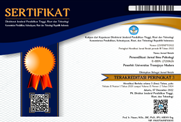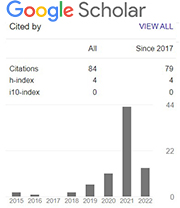Dinamika Resiliensi Wanita pada Masa Emerging Adulthood yang Kehilangan Ayah Karena Serangan Jantung
Abstract
Keywords
Full Text:
PDF (Bahasa Indonesia)References
Aini, D. R., & Satwika, Y. W. (2022). Resiliensi pada wanita dewasa awal setelah kematian pasangan. Character: Jurnal Penelitian Psikologi, 9(6).
Anjarwati, N., Murdiana, S., & Zainuddin, K. (2022). Resiliensi istri pasca kehilangan suami akibat kematian mendadak. Jurnal Sipakalebbi, 6(2), 79–91. https://doi.org/10.24252/sipakallebbi.v6i2.31733
Ansbacher, H. L., & Ansbacher, R. R. (1964). The individual psychology of alfred adler: a systematic presentation in selections from his writings. Harper Perennial.
Arnett, J. J. (2000). Emerging adulthood: a theory of development from the late teens through the twenties. American Psychologist, 55(5), 469–480. https://doi.org/10.1037/0003-066X.55.5.469
Aviano, D. (2020). Perbedaan resiliensi ditinjau dari jenis kelamin pada remaja panti asuhan aceh sepakat di jalan halat medan sumatera utara. Universitas Medan.
Carver, C. S., Scheier, M. F., & Weintraub, K. J. (1989). Assessing coping strategies: a theoretically based approach. Journal of Personality and Social Psychology, 56(2), 267–283. https://doi.org/10.1037/0022-3514.56.2.267
Castetter, C. (2020). The developmental effects on the daughter of an absent father throughout her lifespan. Honors Senior Capstone Projects, 50. files/763/Castetter - The Developmental Effects on the Daughter of an Ab.pdf
Cicchetti, D., & Rogosch, F. A. (1997). The role of self-organization in the promotion of resilience in maltreated children. Development and Psychopathology, 9(4), 797–815. https://doi.org/10.1017/s0954579497001442
Eisma, M. C., Tamminga, A., Smid, G. E., & Boelen, P. A. (2021). Acute grief after deaths due to COVID-19, natural causes and unnatural causes: An empirical comparison. Journal of Affective Disorders, 278, 54–56. https://doi.org/10.1016/j.jad.2020.09.049
Gillies, J., & Neimeyer, R. A. (2006). Loss, grief, and the search for significance: toward a model of meaning reconstruction in bereavement. Journal of Constructivist Psychology, 19(1), 31–65. https://doi.org/10.1080/10720530500311182
Grotberg, E. H. (2003). Resilience for today: gaining strength from adversity. In Choice Reviews Online. Praeger Publishers. https://doi.org/10.5860/choice.41-5592
Hurley, K. (2022). What is resilience? your guide to facing life’s challenges, adversities, and crises.
Indriyani, J., Kusniawati, A., & Kader, M. A. (2020). Pengaruh self esteem dan self efficacy terhadap kepuasan kerja karyawan (studi kasus pada pegawai RSUD Ciamis). Business Management and Enterpreneurship Journal, 2(4), 53–62.
Irawan, W. (n.d.). Peran ayah dalam pengasuhan anak di keluarga urban. Harakat an-nisa 9(1), 11–21.
Istiyati, S., Nuzuliana, R., & Shalihah, M. (2020). Gambaran peran ayah dalam pengasuhan. Profesi (Profesional Islam) : Media Publikasi Penelitian, 17(2), 12–19. https://doi.org/10.26576/profesi.v17i2.22
Jannah, S. N., & Rohmatun, R. (2020). Hubungan antara dukungan sosial dengan resiliensi pada penyintas banjir rob tambak lorok. Proyeksi, 13(1), 1. https://doi.org/10.30659/jp.13.1.1-12
Jihan S. F., & Rahmasari, D. (2024). Pengaruh paparan media sosial tiktok terhadap perilaku self harm pada remaja the effect of tiktok social media exposure on self harm behavior in adolescents. Character Jurnal Penelitian Psikologi | 2024, Vol. 11, No.02| (894-904). https://doi.org/10.26740/cjpp.v11n2.p894-904
Klein, S., & Alexander, D. a. (2003). Good grief: a medical challenge. Trauma, 5(4), 261–271. https://doi.org/10.1191/1460408603ta292oa
Kübler-Ross, E., & Kessler, D. (2014). On grief & grieving: finding the meaning of grief through the five stages of loss. Scribner; Reprint edition. http://www.nber.org/papers/w16019
Lazarus, R. S., & Folkman, S. (1984). Stress, appraisal, and coping. Springer Publishing Company.
Leopold, T., & Lechner, C. M. (2015). Parents’ death and adult well-being: gender, age, and adaptation to filial bereavement. Journal of Marriage and Family, 77(3), 747–760. https://doi.org/10.1111/jomf.12186
Lightsey, O. R. (2006). Resilience, meaning, and well-being. The Counseling Psychologist, 34(1), 96–107. https://doi.org/10.1177/0011000005282369
Lundorff, M., Bonanno, G. A., Johannsen, M., & O’Connor, M. (2020). Are there gender differences in prolonged grief trajectories? a registry-sampled cohort study. Journal of Psychiatric Research, 129, 168–175. https://doi.org/10.1016/j.jpsychires.2020.06.030
Matutina, A. Y. (2021). Resiliensi pada penyintas covid-19. Universitas Katolik Widya Mandala Surabaya.
Meine, L. E., Strömer, E., Schönfelder, S., Eckhardt, E. I., Bergmann, A. K., & Wessa, M. (2021). Look after yourself: students consistently showing high resilience engaged in more self-care and proved more resilient during the covid-19 pandemic. Frontiers in Psychiatry, 12. https://doi.org/10.3389/fpsyt.2021.784381
Nadia, I. (2020). Kematian mendadak karena serangan jantung.
Nasution, E. S. (2022). Resiliensi terhadap kedukaan masyarakat indonesia dalam menghadapi pandemi covid-19. JP3SDM, 11(1), 55–69.
Naufaliasari, A., & Andriani, F. (2013). Resiliensi pada wanita dewasa awal pasca kematian pasangan. Jurnal Psikologi Industri Dan Organisasi, 2(2), 264–269. http://journal.unair.ac.id/filerPDF/jpio10b2b33eca2full.pdf
Parada, S., & Verlhiac, J. F. (2022). Growth mindset intervention among French university students, and its articulation with proactive coping strategies. Educational Psychology, 42(3), 354–374. https://doi.org/10.1080/01443410.2021.1917519
Poerwandari, K. E. (2008). Pendekatan kualitatif untuk penelitian perilaku manusia. Lembaga Pengembangan Sarana Pengukuran dan Pendidikan Psikologi (LPSP3).
Pop-Jordanova, N. (2021). Grief: aetiology, symptoms and management. Prilozi, 42(2), 9–18. https://doi.org/10.2478/prilozi-2021-0014
Porter, N., & Claridge, A. M. (2019). Unique grief experiences: The needs of emerging adults facing the death of a parent. Death Studies, 45(3), 191–201. https://doi.org/10.1080/07481187.2019.1626939
Ramadhanti, M., & Satiningsih. (2022). Gambaran grief pada emerging adulthood yang mengalami kematian orang tua akibat covid-19. Character: Jurnal Penelitian Psikologi, 9(7), 161–178. https://ejournal.unesa.ac.id/index.php/character/article/view/48254
Reivich, K., & Shatte, A. (2002). The resilience factor : 7 keys to finding your inner strength and overcoming life’s hurdles (p. 580). Three Rivers Press.
Rudianto, Z. N. (2022). Pengaruh literasi kesehatan terhadap kesadaran kesehatan mental generasi z di masa pandemi. Jurnal Pendidikan Kesehatan, 11(1), 57. https://doi.org/10.31290/jpk.v11i1.2843
Russell, A., & Saebel, J. (1997). Mother – son , mother – daughter , father – son , and father – daughter : are they distinct relationships ? developmental review, 17, 111–147.
Sambu, L. J., & Mhongo, S. (2019). Age and gender in relation to resilience after the experience of trauma among internally displaced persons (IDPS) in kiambaa village, Eldoret East Sub-County, Kenya. Journal of Psychology & Behavioral Science, 7(1), 31–40. https://doi.org/10.15640/jpbs.v7n1a4
Sampson, W.-G. (2014). Work-related stress in hotels: an analysis of the causes and effects among frontline hotel employees in the kumasi metropolis, ghana. Journal of Tourism & Hospitality, 04(02). https://doi.org/10.4172/2167-0269.1000127
Suciawati, D. T., Sari, H. R., Dewi, L. P., Huriyah, F. S., & Gandana, G. (2024). Peran ayah (fathering) terhadap pengasuhan balita. Jurnal Pendidikan Anak, 13(1), 53–64. https://doi.org/10.21831/jpa.v13i1.335
Sugiyono, D. (2013). Metode penelitian kuantitatif, kualitatif, dan tindakan. Alfabeta.
Sun, J., & Stewart, D. (2007). Age and gender effects on resilience in children and adolescents. International Journal of Mental Health Promotion, 9(4), 16–25. https://doi.org/10.1080/14623730.2007.9721845
Suryadi, T. (2017). Kematian mendadak kardiovaskuler. Jurnal Kedokteran Syiah Kuala, 17(2), 112–118. https://doi.org/10.24815/jks.v17i2.8990
Tugade, M. M., & Fredrickson, B. L. (2004). Resilient individuals use positive emotions to bounce back from negative emotional experiences. Journal of Personality and Social Psychology, 86(2), 320–333. https://doi.org/10.1037/0022-3514.86.2.320
WHO. (2023). ICD-11 for mortality and morbidity statistics. https://icd.who.int/browse11/l-m/en#/http%3A%2F%2Fid.who.int%2Ficd%2Fentity%2F426429380
Wibowo. (2019). Kematian mendadak capai 50-100 persen per 100.000 populasi.
Widyataqwa, A. C. J., & Rahmasari, D. (2022). Resiliensi istri selepas kematian suami akibat covid-19. Character: Jurnal Penelitian Psikologi, 8(9), 103–118. https://ejournal.unesa.ac.id/index.php/character/article/view/42623
Willig, C. (2008). The SAGE handbook of qualitative research in psychology. In SAGE Publications Inc (Issue 184).
Wiyoga, R. L., Indriarti, M. R., & Septiawan, D. (2023). Prolonged grief disorder di masa pandemi covid-19: suatu tinjauan pustaka. Jurnal Kedokteran Meditek, 29(3), 314–326. https://doi.org/10.36452/jkdoktmeditek.v29i3.2656
Wolin, S. j, & Wolin, S. (1993). The resilience self: how a survivor of troubled families rises above adversity. Villard.
Yuniar, N. (2022). Mengapa lelaki lebih rentan terkena penyakit jantung? https://www.antaranews.com/berita/3147445/mengapa-lelaki-lebih-rentan-terkena-penyakit-jantung
DOI: https://doi.org/10.21107/personifikasi.v16i1.25189
Refbacks
- There are currently no refbacks.
Copyright (c) 2025 Patricia Irewa Tantoro, Yettie Wandansari, Detricia Tedjawidjaja

This work is licensed under a Creative Commons Attribution 4.0 International License.


Personifikasi by Universitas Trunojoyo Madura is licensed under a Creative Commons Attribution 4.0 International License.










